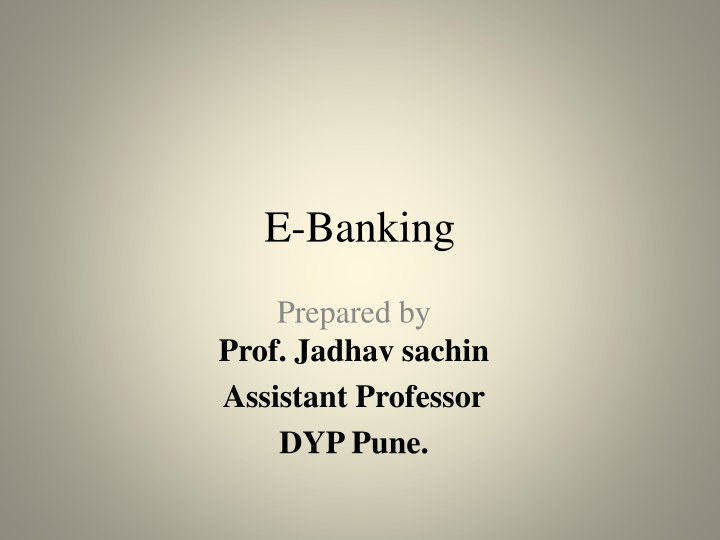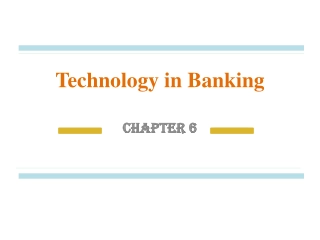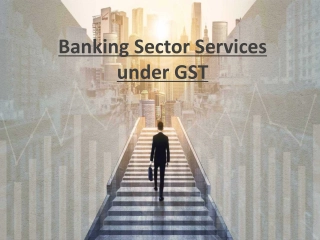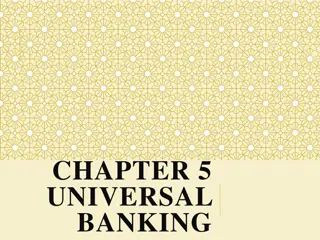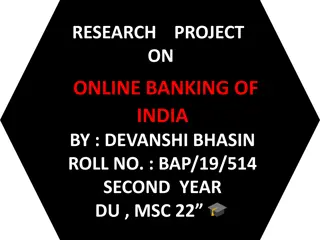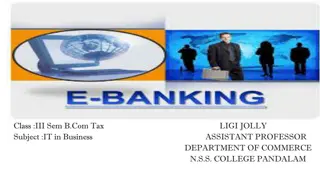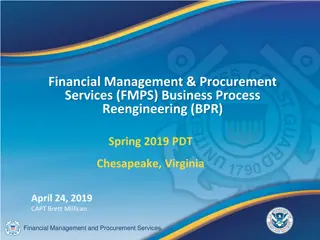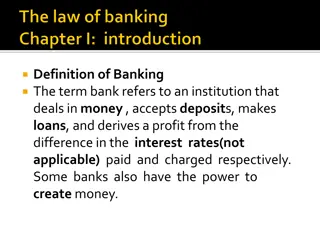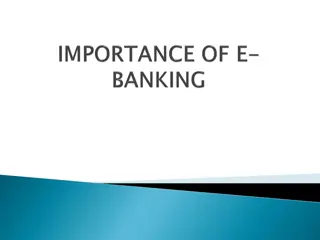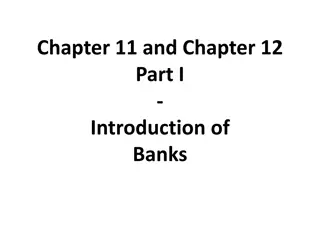Modernizing Banking Services Through E-Banking
Many banks have modernized their services through e-banking, offering customers convenience and flexibility in managing their finances. E-banking provides various services such as credit cards, debit cards, ATM transactions, and more. Customers benefit from anywhere and anytime banking, reduced costs, and easy access to banking services.
Download Presentation

Please find below an Image/Link to download the presentation.
The content on the website is provided AS IS for your information and personal use only. It may not be sold, licensed, or shared on other websites without obtaining consent from the author.If you encounter any issues during the download, it is possible that the publisher has removed the file from their server.
You are allowed to download the files provided on this website for personal or commercial use, subject to the condition that they are used lawfully. All files are the property of their respective owners.
The content on the website is provided AS IS for your information and personal use only. It may not be sold, licensed, or shared on other websites without obtaining consent from the author.
E N D
Presentation Transcript
E-Banking Prepared by Prof. Jadhav sachin Assistant Professor DYP Pune.
E-Banking Many banks have modernized their services with the facilities of computer and electronic equipments. The electronics revolution has made it possible to provide ease and flexibility in banking operations to the benefit of the customer. The e-banking has made the customer say good-bye to huge account registers and large paper bank accounts
The e-banks, which may call as easy bank offers the following services to its customers Credit Cards Debit Cards ATM E-Cheque EFT (Electronic Funds Transfer) D-MATAccounts Mobile Banking Telephone Banking Internet Banking EDI (Electronic Data Interchange)
Benefits of E-banking To the Customer Anywhere Banking no matter wherever the customer is in the world. Balance enquiry, request for services, issuing instructions etc., from anywhere in the world is possible. Anytime Banking Managing funds in real time and most importantly, 24 hours a day, 7days a week. Convenience acts as a tremendous psychological benefit all the time. Brings down Cost of Banking to the customer over a period a period of time. Cash withdrawal from any branch /ATM On-line purchase of goods and services including online payment for the same.
Major Functions of International Banking 1. Facilitate imports and exports of their clients trade financing 2. Arrange for foreign transactions and foreign investments 3.Assist in hedging exchange rate risk 4. Trade foreign exchange products for their own account 5. Borrow and lend in the Eurocurrency market 6. Participate in international loan syndicate lending to MNCs- project financing and to sovereign governments economic development 7. Participate in underwriting of Eurobonds and foreign bonds issues. 8. Provide consultancy and advice on hedging strategies, interest rate and currency international cash management services exchange cross-border swap financing and
Broad Classification of Banks in India 1) The RBI: The RBI is the supreme monetary and banking authority in the country and has the responsibility to control the banking system in the country. It keeps the reserves of all scheduled banks and hence is known as the Reserve Bank . 2) Public Sector Banks: State Bank of India and itsAssociates (8) Nationalized Banks (19) Regional Rural Banks Sponsored by Public Sector Banks (196) 3) Private Sector Banks: Old Generation Private Banks (22) Foreign New Generation Private Banks (8) Banks in India (40)
4) Co-operative Sector Banks: State Co-operative Banks Central Co-operative Banks Primary Agricultural Credit Societies Land Development Banks State Land Development Banks 5) Development Banks: Development Banks mostly provide long term finance for setting up industries. They also provide short-term finance (for export and import activities) Industrial Finance Co-operation of India (IFCI) Industrial Development of India (IDBI) Industrial Investment Bank of India (IIBI) Small Industries Development Bank of India (SIDBI) National Bank for Agriculture and Rural Development (NABARD) Export-Import Bank of India
Commercial Banks Commercial banks comprising public sector banks, foreign banks, and private sector banks represent the most important financial intermediary in the Indian financial system. The changes in banking structure and control have resulted due to wider geographical spread and deeper penetration of mobilization of deposits, reallocation of bank credit to priority activities, and lower operational autonomy for a bank management.Public sector commercial banks, dominate the commercial banking scene in the country.The largest commercial Banks in India is SBI rural areas, higher 8
Main function of commercial banks A ) Acceptance of deposits Fixed deposit account Saving bank account Current account B ) Advancing of loan Cash credit Call loans Over draft Bills discounting
Main function of commercial banks cont- C) Agency function Collecting receipts Making payments Buy and sell securities Trustee and executor D ) General utility function Issuing letters of credit, travelers cheques Underwriting share and debentures Safe custody of valuables Providing ATM and credit card facilities Providing credit information
Cooperative Bank These banks play a vital role in mobilizing savings and stimulating agricultural investment. Co-operative credit institutions account for the second largest proportion of 44.6% of total institutional credit. The co-operative sector is very much useful for rural people. The co-operative banking sector is divided into the following categories. State co-operative Banks Central co-operative banks Primary Agriculture Credit Societies 11
Development Banks A development bank may be defined as a financial institution concerned with providing all types of financial assistance to business units in the form of loans, underwriting, investment and guarantee operations and promotional activities-economic development in general and industrial development in particular A development bank is basically a term lending institution. It is a multipurpose financial institution with a broad development outlook. The industrial finance corporation of India, the first development bank was established in 1948. Subsequently many other institutions were set-up. Ex. IDBI, IFCI, SIDBI etc. 12
Functions of Development Banks Fostering industrial growth Providing Long term assistant Balanced development Providing Promotional services Infrastructure building Entrepreneur Development Fulfilling Socio economic objectives 13
Investment Banks Meaning: Financial intermediaries that acquire the savings of people and direct these funds into the business enterprises seeking capital for the acquisition of plant and equipment and for holding inventories are called investmentbanks . Features: Long term financing, Security, merchandiser, Security middlemen, Insurer, Underwriter Functions: Capital formation, Underwriting, Purchase of securities, Selling of securities, Advisory services, Acting as dealer. 14
Merchant Banks Meaning: Institution that render wide range of services such as the management of customer s securities, portfolio management, counseling, insurance, etc are called MerchantBanks . Functions: Sponsoring issues, Loan syndication, Servicing of issues, Portfolio, management, Arranging fixed deposits, Helps in merger& acquisition 15
List of commercial banks Public sector bank State Bank of India Punjab & Sind Bank Dena Bank Bank of Maharashtra Allahabad Bank Punjab National Bank Indian Bank Canara Bank Andhra Bank Syndicate Bank Indian Overseas Bank Central Bank of India Bank of Baroda Union Bank of India Oriental Bank of Commerce Corporation Bank Bank of India United Bank of India IDBI Bank UCO Bank Vijaya Bank
Indian private banks *Axis Bank *IndusInd Bank *Bank of Rajasthan *ING Vysya Bank *Bharat Overseas Bank *Jammu & Kashmir Bank *Catholic Syrian Bank *Karnataka Bank Limited *Centurion Bank of Punjab *Karur Vysya Bank *City Union Bank *Kotak Mahindra Bank *Development Credit Bank *Lakshmi Vilas Bank *Dhanalakshmi Bank *Nainital Bank *Federal Bank *Ratnakar Bank *Ganesh Bank of Kurundwad *SBI Commercial and International Bank *HDFC Bank *South Indian Bank *ICICI Bank *Tamilnad Mercantile Bank Ltd. *YES Bank
List of Foreign banks in India ABN-AMRO Bank Abu Dhabi Commercial Bank Ltd American Express Bank Ltd Citibank DBS Bank Ltd Deutsche Bank HSBC Ltd Standard Chartered Bank
The Role of Reserve Bank of India (RBI) -Banker s Bank The Reserve Bank of India (RBI) is the central bank of India, and was established on April 1, 1935 in accordance with the provisions of the Reserve Bank of India Act, 1934. Since its inception, it has been headquartered in Mumbai. Though originally privately owned, RBI has been fully owned by the Government of India since nationalization in 1949. RBI is governed by a central board (headed by a Governor) appointed by the Central Government.RBI has 22 regional offices across India. The Reserve Bank of India was set up on the recommendations of the Hilton Young Commission.
Functions of RBI Monetary Authority Formulates, implements and monitors the monetary policy. Objective: maintaining price stability and ensuring adequate flow of credit to productive sectors Regulator and supervisor of the financial system Prescribes broad parameters of banking operations within which the country s banking and financial system functions. Objective: Maintain public confidence in the system, protect depositors interest and provide cost-effective banking services to the public. The Banking Ombudsman Scheme has been formulated by the Reserve Bank of India (RBI) for effective redressal of complaints by bank customers
Functions of RBI cont- Manager of Foreign Exchange and Control Manages the foreign exchange through Foreign Exchange Management Act, 1999. Objective: to facilitate external trade and payment and promote orderly development and maintenance of foreign exchange market in India. Issuer of currency Issues and exchanges or destroys currency and coins not fit for circulation. Objective: to give the public adequate quantity of supplies of currency notes and coins and in good quality
Functions of RBI cont- Developmental role Performs a wide range of promotional functions to support national objectives Related Functions Banker to the Government: performs merchant banking function for the central and the state governments; also acts as their banker. Banker to banks: maintains banking accounts of all scheduled banks. Owner and operator of the depository (SGL) and exchange (NDS) for government bonds
Functions of RBI cont- Supervisory Functions: In addition to its traditional central functions, the Reserve bank has certain non-monetary functions of the nature of supervision of banks and promotion of sound banking in India. The Reserve Bank Act, 1934, and the Banking Regulation Act, 1949 have given the RBI wide powers of supervision and control over commercial and cooperative banks, relating to licensing and establishments, branch expansion, liquidity of their assets, management and methods of working, amalgamation, reconstruction and liquidation. The RBI is authorized to carry out periodical inspections of the banks and to call for returns and necessary information from them.. The supervisory functions of the RBI have helped a great deal in improving the standard of banking in India to develop on sound lines and to improve the methods of their operation.
Functions of RBI cont- Promotional Functions: The Reserve Bank now performs a variety of developmental and promotional functions. The Reserve Bank promotes banking habit, extend banking facilities to rural and semi-urban areas, and establish and promote new specialized financing agencies. The Reserve bank has helped in the setting up of the IFCI and the SFC: it set up the Deposit Insurance Corporation of India in 1963 and the Industrial Reconstruction Corporation of India in 1972. These institutions were set up directly or indirectly by the Reserve Bank to promote saving habit and to mobilize savings, and to provide industrial finance as well as agricultural finance. The RBI set up the Agricultural Credit Department in 1935 to provide agricultural credit. The Bank has developed the co-operative credit movement to encourage saving, to eliminate money-lenders from the villages and to route its short term credit to agriculture. The RBI has set up the Agricultural Refinance and Development Corporation to provide long-term finance to farmers
Products and Services offered by Banks The different products in a bank can be broadly classified into: Retail Banking Trade Finance Treasury Operations. Retail Banking and Trade finance operations are conducted at the branch level while the wholesale banking operations, which cover treasury operations, are at the hand office or a designated branch.
Retail Banking: Deposits Loans, Cash Credit and Overdraft Negotiating for Loans and advances Remittances Book-Keeping (maintaining all accounting records) Receiving all kinds of bonds valuable for safe keeping Trade Finance: Issuing and confirming of letter of credit. Drawing, accepting, discounting, buying, selling, collecting of bills of exchange, promissory notes, drafts, bill of lading and other securities.
Treasury Operations: Buying and selling of bullion. Foreign exchange Acquiring, holding, underwriting and dealing in shares, debentures, etc. Purchasing and selling of bonds and securities on behalf of constituents. The banks can also act as an agent of the Government or local authority. They insure, guarantee, underwrite, participate in managing and carrying out issue of shares, debentures, etc. Apart from functions of the bank, the bank provides a whole lot of other services like investment individuals, short-term funds management and portfolio management for individuals and companies. It undertakes the inward and outward remittances with reference to foreign exchange and collection of varied types for the Government the above-mentioned counseling for
Common Banking Products Available: Credit Card: Credit Card is postpaid or paylater card that draws from a credit line-money made available by the card issuer (bank) and gives one a grace period to pay. If the amount is not paid full by the end of the period, one is charged interest Debit Cards: Debit Card is a prepaid or paynow card with some stored value. Debit Cards quickly debit or subtract money from one s savings account, or if one were taking out cash. Every time a person uses the card, the merchant who in turn can get the money transferred to his account from the bank of the buyers, by debiting an exact amount of purchase from the card. To get a debit card along with a Personal Identification Number (PIN).
Automatic Teller Machine: The ATMs are used by banks for making the customers dealing easier. ATM card is a device that allows customer who has an ATM card to perform routine banking transaction at any time without interacting with human teller. It provides exchange services. This service helps the customer to withdraw money even when the banks ate closed. This can be done by inserting the card in the ATM and entering the Personal Identification Number and secret Password.It allows the customers To transfer money to and from accounts. To view account information. To order cash. To receive cash.
Electronic Funds Transfer (EFT):. The system called electronic fund transfer (EFT) automatically transfers money from one account to another. This system facilitates speedier transfer of funds electronically from any branch to any other branch. In this system the sender and the receiver of funds may be located in different cities and may even bank with different banks. Funds transfer within the same city is also permitted. The scheme has been in operation since February 7, 1996, in India. Telebanking: Telebanking refers to banking on phone services. A customer can access information about his/her account through a telephone call and by giving the coded Personal Identification Number (PIN) to the bank. Telebanking is extensively user friendly and effective in nature.
Mobile Banking: A new revolution in the realm of e-banking is the emergence of mobile banking. On-line banking is now moving to the mobile world, giving everybody with a mobile phone access to real-time banking services, regardless of their location. It provides a new way to pick up information and interact with the banks to carry out the relevant banking business. The potential of mobile banking is limitless and is expected to be a big success. Booking and paying for travel and even tickets is also expected to be a growth area.This is a very flexible way of transacting banking business.
Internet Banking: Internet banking involves use of internet for delivery of banking products and services. Banking is no longer confined to the branches where one has to approach the branch in person, to withdraw cash or deposits a cheque or request a statement of accounts. In internet banking, any inquiry or transaction is processed online without any reference to the branch (anywhere banking) at any time. Benefits of Internet Banking: Reduce the transaction costs of offering several banking services and diminishes the need for longer numbers of expensive brick and mortar branches and staff. Increase convenience for customers, since they can conduct many banking transaction 24 hours a day. Increase customer loyalty. Improve customer access. Attract new customers. Easy online application for all accounts, including personal loans and mortgages
Banking Services Banking covers many services, these basic services have always been recognized as the hallmark of the genuine banker. These are The receipt of the customer s deposits The collection of cheques drawn on other banks The payment of the customer s cheques drawn on himself There are other various types of banking services like: Advances Overdraft, Cash Credit, etc. Deposits Saving Account, Current Account, etc. Financial Services Bill discounting etc. Foreign Services Providing foreign currency, travelers cheques, etc. Money Transmission Funds transfer etc. Savings Fixed deposits, etc. Services of place or time ATM Services. Status Debit Cards, Credit Cards, etc.
Bank Lending Banks extend credit to different categories of borrowers for a wide variety of purposes. Bank credit is provided to households, retail traders, small and medium enterprises (SMEs), corporates, the Government undertakings etc. in the economy. Retail banking loans are accessed by consumers of goods and services for financing the purchase of consumer durables, housing or even for day-to-day consumption. In contrast, the need for capital investment, and day-to-day operations of private corporates and the Government undertakings are met through wholesale lending. Loans for capital expenditure are usually extended with medium and long-term maturities, while day-to-day finance requirements are provided through short-term credit (working capital loans). Meeting the financing needs of the agriculture sector is also an important role that Indian banks play.
Principles of lending Safety: Banks need to ensure that advances are safe and money lent out by them will come back. Since the repayment of loans depends on the borrowers' capacity to pay, the banker must be satisfied before lending that the business for which money is sought is a sound one. In addition, bankers many times insist on security against the loan, which they fall back on if things go wrong for the business. The security must be adequate, readily marketable and free of encumbrances. Liquidity: To maintain liquidity, banks have to ensure that money lent out by them is not locked up for long time by designing the loan appropriately. Further, money must come back as per the repayment schedule. If loans become excessively illiquid, it may not be possible for bankers to meet their obligations vis- -vis depositors. maturity period
Profitability: To remain viable, a bank must earn adequate profit on its investment. This calls for adequate margin between deposit rates and lending rates. In this respect, appropriate fixing of interest rates on both advances and deposits is critical. Unless interest rates are competitively fixed and margins are adequate, banks may lose customers to their competitors and become unprofitable. Risk diversification: To mitigate risk, banks should lend to a diversified customer base. Diversification should be in terms of geographic location, nature of business etc.
Loan Policy Based on the general principles of lending stated above, the Credit Policy Committee (CPC) of individual banks prepares the basic credit policy of the Bank, which has to be approved by the Bank's Board of Directors. The loan policy outlines lending guidelines and establishes operating procedures in all aspects of credit management including standards for presentation of credit proposals, rating standards and benchmarks, delegation of credit approving powers, prudential limits on large credit exposures, asset concentrations, portfolio management, loan review mechanism, risk monitoring and evaluation, pricing of loans, provisioning for bad debts, regulatory/ legal compliance etc The loan policy typically lays down lending guidelines in the following areas: Level of credit-deposit ratio Targeted portfolio mix Ratings Loan pricing Collateral security
Loan Policy cont- Credit Deposit (CD) Ratio: A bank can lend out only a certain proportion of its deposits, since some part of deposits have to be statutorily maintained as Cash Reserve Ratio (CRR) deposits, and an additional part has to be used for making investment in prescribed securities (Statutory Liquidity Ratio or SLR requirement). It may be noted that these are minimum requirements. Banks have the option of having more cash reserves than CRR requirement and invest more in SLR securities than they are required to. Targeted Portfolio Mix: The CPC aims at a targeted portfolio mix keeping in view both risk and return. Toward this end, it lays down guidelines on choosing the preferred areas of lending (such as sunrise sectors and profitable sectors) as well as the sectors to avoid. Banks typically monitor all major sectors of the economy. They target a portfolio mix in the light of forecasts for growth and profitability for each sector. If a bank perceives economic weakness in a sector, it would restrict new exposures to that segment and similarly, growing and profitable sectors of the economy prompt banks to increase new exposures to those sectors. This entails active portfolio management.
Fund-based Services (Lending) for Individuals Credit Card : The customer swipes the credit card to make his purchase. His seller will then submit the details to the card issuing bank to collect the payment. The bank will deduct its margin and pay the seller. The bank will recover the full amount from the customer (buyer). The margin deducted from the seller s payment thus becomes a profit for the card issuer. Personal Loans: These are often unsecured loans provided to customers who use these funds for various purposes such as higher education, medical expenses, social events and holidays. Sometimes collateral security in the form of physical and financial assets may be available for securing the personal loan
Vehicle Finance : This is finance which is made available for the specific purpose of buying a car or a two-wheeler or other automobile. The interest rate for used cards can go close to the personal loan rates. However, often automobile manufacturers work out special arrangements with the financiers to promote the sale of the automobile. This makes it possible for vehicle-buyers to get attractive financing terms for buying new vehicles. Home Finance: Banks extend home finance loans, either directly or through home finance subsidiaries. Such long term housing loans are provided to individuals and corporations and also given as construction finance to builders. The loans are secured by a mortgage of the property financed. These loans are extended for maturities generally ranging from five to fifteen years and a large proportion of these loans are at floating rates of interest
Non-Fund-based Services For Business Letter of Credit : When Party A supplies goods to Party B, the payment terms may provide for a Letter of Credit. In such a case, Party B (buyer, or opener of L/C) will approach his bank (L/C Issuing Bank) to pay the beneficiary (seller) the value of the goods, by a specified date, against presentment of specified documents. The bank will charge the buyer a commission, for opening the L/C. The L/C thus allows the Part A to supply goods to Party B, without having to worry about Party B s credit-worthiness. It only needs to trust the bank that has issued the L/C. It is for the L/C issuing bank to assess the credit-worthiness of Party B. Normally, the L/C opener has a finance facility with the L/C issuing bank. The L/C may be inland (for domestic trade) or cross border (for international trade).
Guarantee: In business, parties make commitments. The beneficiary of the commitment wants to be sure that the party making the commitment (obliger) will live up to the commitment. This comfort is given by a guarantor, whom the beneficiary trusts. Banks issue various guarantees in this manner, and recover a guarantee commission from the obliger. The guarantees can be of different kinds, such as Financial Guarantee, Deferred Payment Performance Guarantee, depending on how they are structured Loan Syndication: This investment banking role is performed by a number of universal banks Guarantee and
Non-Fund-based Services For Individuals Sale of Financial Products such as mutual funds and insurance is another major service offered by universal banks. Financial Planning and Wealth Management are offered by universal banks. Executors and Trustees: a department within banks help customers in managing succession of assets to the survivors or the next generation. Lockers: a facility that most Indian households seek to store ornaments and other valuables
Money Remittance Services Demand Draft / Banker s Cheque / Pay Order National Electronic Funds Transfer (NEFT):National Electronic Funds Transfer (NEFT) is a nation-wide system that facilitates individuals, firms and corporates to electronically transfer funds from any bank branch to any individual, firm or corporate having an account with any other bank branch in the country. In order to issue the instruction, the transferor should know not only the beneficiary s bank account number but also the IFSC (Indian Financial System Code) of the concerned bank. IFSC is an alpha-numeric code that uniquely identifies a bank-branch participating in the NEFT system. This is a 11 digit code with the first 4 alpha characters representing the bank, and the last 6 numeric characters representing the branch. The 5th character is 0 (zero). IFSC is used by the NEFT system to route the messages to the destination banks / branches
Real Time Gross Settlement (RTGS): RTGS transfers are instantaneous unlike National Electronic Funds Transfer (NEFT) where the transfers are batched together and effected at hourly intervals. RBI allows the RTGS facility for transfers above Rs1lakhs. The RBI window is open on weekdays from 9 am to 4.30 pm; on Saturdays from 9 am to 12.30 pm Society for Worldwide Telecommunications (SWIFT): SWIFT is solely a carrier of messages. It does not hold funds nor does it manage accounts on behalf of customers, nor does it store financial information on an on-going basis. As a data carrier, SWIFT transports messages between two financial institutions. This activity involves the secure exchange of proprietary data while ensuring its confidentiality and integrity. SWIFT, which has its headquarters in Belgium, has developed an 8-alphabet Bank Identifier Code (BIC). The BIC helps identify the bank Interbank Financial
Non Performing Assets An asset of a bank (such as a loan given by the bank) turns into a non-performing asset (NPA) when it ceases to generate regular income such as interest etc for the bank. In other words, when a bank which lends a loan does not get back its principal and interest on time, the loan is said to have turned into an NPA Banks have to classify their assets as performing and non- performing in accordance with RBI's guidelines. Under these guidelines, an asset is classified as non-performing if any amount of interest or principal installments remains overdue for more than 90 days, in respect of term loans. In respect of overdraft or cash credit, an asset is classified as non-performing if the account remains out of order for a period of 90 days and in respect of bills purchased and discounted account, if the bill remains overdue for a period of more than 90 days.
International Banking International intermediaries that bid for time deposits and make loans in the offshore market It is an unregulated market involving greater risk It is a wholesale segment of lending and deposit activity International banking brings together borrowers and lenders from same country or different countries They are substitutes for the domestic banking system banking relates to financial
